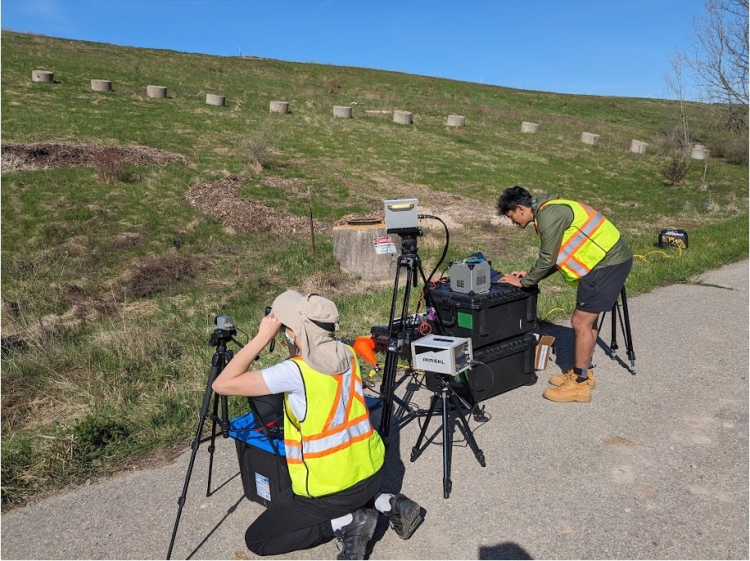Waterloo researchers are at the forefront of responding to the climate crisis with purpose-driven research and technology, including an interdisciplinary team who are in the field measuring methane emissions to support Canada's net-zero gas emissions goals.
Methane is a very powerful greenhouse gas approximately 80 times more potent than carbon dioxide (CO2) over a 20-year period. It also has far shorter lifetime compared to CO2, which means that methane emissions must be reduced urgently to avoid the worst outcomes of climate change, like natural disasters, forest fires, heat death and starvation. Addressing this problem requires an understanding of where methane comes from, how to measure it and how to reduce it. Researchers across the faculties of Science, Environment, Mathematics and Engineering have come together to tackle this critical issue.
Among other cutting-edge instruments, the team deploys a hyperspectral camera, also known as a "Hyper-Cam," developed by Quebec City-based Telops. Unlike a normal camera, which makes a single image, the Hyper-Cam makes hundreds of images of the same scene, but each at a different wavelength. At the heart of the instrument is a high-speed infrared camera that works fast enough to visualize the wind moving across a field through the absorption of ambient water vapour.
The research team, led by Dr. Kyle Daun, a professor in the Department of Mechanical and Mechatronics Engineering, is using the Hyper-Cam to help the Region of Waterloo to measure methane emissions at their Erb Street landfill site. Landfills contribute to 20 per cent of Canada's methane emissions, the majority through hotspots areas of a landfill that have considerably higher levels of methane. At the same time, a team of researchers led by Dr. Laura Hug in the Department of Biology studies the microbes living in the soil and the impact of the hotspots on those organisms.

The research team measuring methane at the Waterloo Region landfill
"We're seeing what microbes are present in the cover soil and how they are responding to the increase in methane or change in environment," Hug shares.
The team's goal is to identify methane-breathing microbes to measure how much of the hotspot methane is being consumed in soil before it is released into the atmosphere. Ideally, microbes capable of handling these large volumes of methane will be found and can be applied to other hotspots, reducing the emissions impact of these sites.
The team can then make recommendations to the regional landfill on which spots need to be covered up or plugged.
As Canada aims to have net-zero greenhouse gas emissions by 2050, reducing methane emissions is crucial to achieving this goal, and Hug affirms landfills are a huge priority in reaching this goal.
The team's partners at the waste management site are thankful for this work. "With anticipated regulatory changes from Environment and Climate Change Canada, looking at alternative quantification methodologies and treatment approaches is both relevant and valuable to future operations," says Brittney Crawford, an environmental engineer.
The team also works with Telops to develop techniques for detecting and quantifying methane emissions from upstream oil and gas sites in Western Canada using a downward-looking Hyper-Cam on a helicopter. Oil and gas companies use this information to find and repair leaks from pipelines and oil and gas facilities. At the same time, provincial regulators check emission rates to ensure that companies abide by Canada's environmental laws.
The airborne Hyper-Cam mounted in a helicopter to detect and measure methane emissions from Canada's oil and gas industry.
The team is passionate about their work across various industries and is eager to see how it inspires meaningful change. "The overarching benefits we expect is an improvement in the accuracy of methane emission rates from human activity, leading to better enforcement of regulations associated with the emission of methane, and a better understanding of the role of methane in our changing climate," says Arpan Singh, a doctoral student in mechanical and mechatronics engineering.
Industries and researchers cannot reduce what they cannot measure. Technology like the Hyper-Cam, combined with a multidisciplinary team, can have a real impact on the safety and quality of life of communities across Canada.













